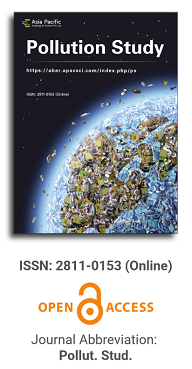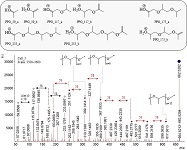
Asia Pacific Academy of Science Pte. Ltd. (APACSCI) specializes in international journal publishing. APACSCI adopts the open access publishing model and provides an important communication bridge for academic groups whose interest fields include engineering, technology, medicine, computer, mathematics, agriculture and forestry, and environment.

The (partial) replacement of synthetic polymers with bioplastics is due to increased production of conventional packaging plastics causing for severe environmental pollution with plastics waste. The bioplastics, however, represent complex mixtures of known and unknown (bio)polymers, fillers, plasticizers, stabilizers, flame retardant, pigments, antioxidants, hydrophobic polymers such as poly(lactic acid), polyethylene, polyesters, glycol, or poly(butylene succinate), and little is known of their chemical safety for both the environment and the human health. Polymerization reactions of bioplastics can produce no intentionally added chemicals to the bulk material, which could be toxic, as well. When polymers are used to food packing, then the latter chemicals could also migrate from the polymer to food. This fact compromises the safety for consumers, as well. The scarce data on chemical safety of bioplastics makes a gap in knowledge of their toxicity to humans and environment. Thus, development of exact analytical protocols for determining chemicals of bioplastics in environmental and food samples as well as packing polymers can only provide warrant for reliable conclusive evidence of their safety for both the human health and the environment. The task is compulsory according to legislation Directives valid to environmental protection, food control, and assessment of the risk to human health. The quantitative and structural determination of analytes is primary research task of analysis of polymers. The methods of mass spectrometry are fruitfully used for these purposes. Methodological development of exact analytical mass spectrometric tools for reliable structural analysis of bioplastics only guarantees their safety, efficacy, and quality to both humans and environment. This study, first, highlights innovative stochastic dynamics equations processing exactly mass spectrometric measurands and, thus, producing exact analyte quantification and 3D molecular and electronic structural analyses. There are determined synthetic polymers such as poly(ethylenglycol), poly(propylene glycol), and polyisoprene as well as biopolymers in bags for foodstuffs made from renewable cellulose and starch, and containing, in total within the 20,416–17,495 chemicals per sample of the composite biopolymers. Advantages of complementary employment in mass spectrometric methods and Fourier transform infrared spectroscopy is highlighted. The study utilizes ultra-high resolution electrospray ionization mass spectrometric and Fourier transform infrared spectroscopic data on biodegradable plastics bags for foodstuffs; high accuracy quantum chemical static methods, molecular dynamics; and chemometrics. There is achieved method performance |r| = 0.99981 determining poly(propylene glycol) in bag for foodstuff containing 20,416 species and using stochastic dynamics mass spectrometric formulas. The results highlight their great capability and applicability to the analytical science as well as relevance to both the fundamental research and to the industry.
Methodology and results of surface water quality monitoring in Georgia
Vol 5, Issue 2, 2024
Download PDF
Abstract
The article reviews the existing methodology and results of monitoring the quality of surface waters in Georgia. It also discusses improving the existing monitoring network and its approximation to the EU Water Framework Directive. The monitoring results are related to water quality indicators (chemical analysis) and pollution assessment. Georgia stands out worldwide for its biological and landscape diversity, features of an ecologically clean natural environment, water resources and a history of agricultural development of several thousand years. Despite this, the indicators of chemical and biological pollution of water bodies are still high. In Georgia, the quality of water bodies is monitored in several dozen locations (points). The monitoring results are the subject of constant attention and discussion. The importance of water quality monitoring is increasing even more against climate change trends when the demand for both water resources and their quality is constantly growing.
Keywords
References
- Elizbarashvili N, Meladze G, Khoetsyan A, et al. Sustainable development of Mountain regions and resource management. Dani; 2018. pp. 304.
- Elizbarashvili N, Davitashvili Z, Sichinava D, et al. Public Geography of Georgia Textbook for students of higher education institutions. Ivane Javakhishvili Tbilisi State University Press; 2021. pp.334.
- WHO. Drinking-water. Available online: https://www.who.int/news-room/fact-sheets/detail/drinking-water (accessed on 17 November 2024).
- Coraggio E, Han D, Tryfonas T. Smart cities and hydroinformatics. Handbook of Hydroinformatics. 2023; 2: 341-355. doi: 10.1016/b978-0-12-821961-4.00029-4
- Order of the Minister on Sanitary Rules for Water Sampling. Available online: https://www.matsne.gov.ge/ka/document/view/57166 (accessed on 17 November 2024).
- Law of Georgia on Water Resources Management. Available online: https://matsne.gov.ge/ka/document/view/5846594?publication=0 (accessed on 17 November 2024).
- EU Water Initiative Plus for the Eastern Partnership Countries (EUWI+), Development of the Khrami-Debeda River Basin Management Plan in Georgia, 2020. Available online: https://www.euwipluseast.eu/images/2021/05/PDF/Khrami-Debeda-RBMP-GE__29012021.pdf (accessed on 17 November 2024).
- Available online: https://old.tsu.ge/science/?leng=ge&cat=jurnal&jnomeri=6&tid=3 (accessed on 17 November 2024).
- Available online: https://georgiantravelguide.com/ka/kumisis-tba (accessed on 17 November 2024).
- Guidance on surface water chemical monitoring under the water framework directive: Guidance Document No.19. Available online: https://op.europa.eu/en/publication-detail/-/publication/91d313f0-2cc7-4874-b101-a7dba97401b0 (accessed on 17 November 2024).
- National Environmental Agency’s Brief Overview of Environmental Pollution in Georgia Newsletter, 2023, N1-12. Available online: https://nea.gov.ge/Ge/Departments/Polution/Biulettins?year=2023 (accessed on 17 November 2024).
- Directive 2000/60/EC of the European Parliament and of the Council of 23 October 2000 establishing a framework for Community action in the field of water policy. Available online: https://eur-lex.europa.eu/eli/dir/2000/60/oj (accessed on 17 November 2024).
- Zhang L. Different methods for the evaluation of surface water quality: The Case of the Liao River, Liaoning Province, China. International review for spatial planning and sustainable development. 2017; 5(4): 4-18. doi: 10.14246/irspsd.5.4_4
- Nguyen TG, Huynh THN. Assessment of surface water quality and monitoring in southern Vietnam using multicriteria statistical approaches. Sustainable Environment Research. 2022; 32(1). doi: 10.1186/s42834-022-00133-y
- Technical Regulations for the Protection of Surface Waters of Georgia from Pollution. Available online: https://www.matsne.gov.ge/ka/document/view/4207689 (accessed on 17 November 2024).
Supporting Agencies
Copyright (c) 2024 Nodar Elizbarashvili, Gela Sandodze
License URL: https://creativecommons.org/licenses/by/4.0/

This site is licensed under a Creative Commons Attribution 4.0 International License (CC BY 4.0).
.jpg)
Beijing University of Technology, China



